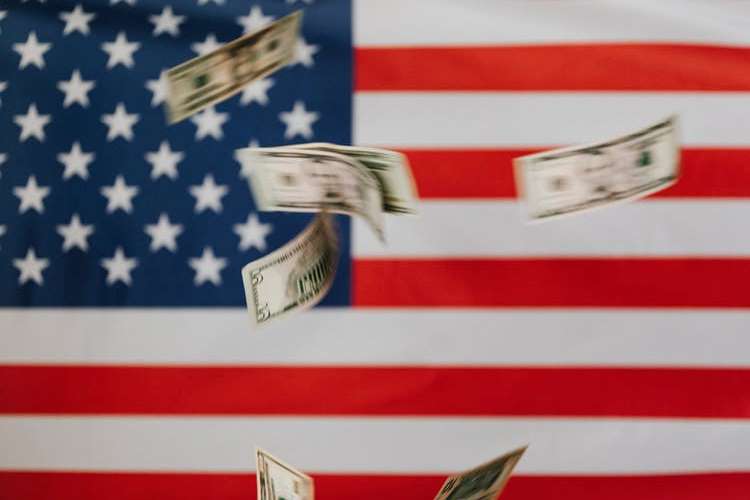Rising Debt Means A Weaker Dollar
Americans appear to be growing more concerned about the skyrocketing national debt level – officially $28.1 trillion and counting.
The Peter G. Peterson Foundation’s monthly Fiscal Confidence Index recently shed five points, dropping to a level of 47, in the wake of the Biden Administration’s latest $2 trillion stimulus package.
That $2 trillion bill is simply piled on top of already massive budget deficits.
And it adds further to concerns over the country’s currency, the Federal Reserve Note “dollar”.

Image Source: Pexels
Federal debt is currently the largest as a percentage of the economy since World War II. Given that no amount of tax hikes will yield enough capital to cover the debt, the nation now finds itself on an unsustainable trajectory towards bankruptcy.
The only viable way for the government to dig itself out of its debt predicament is by leaning on its banker, the Federal Reserve.
The Fed now buys $120 billion in bonds every month, artificially suppresses interest rates and intentionally targets higher inflation. These maneuvers make issuing and servicing government debt cheaper in real terms.
The national debt went seemingly unnoticed, for years. The consequences of massive overspending are becoming increasingly clear, however. Among them are a weaker dollar and decline in national credibility.
As the U.S. dollar loses value, it could also lose its preeminent spot on the international stage.
Other countries, such as China, continue to move away from the dollar as the global reserve currency of choice by reducing their holdings of U.S. Treasuries, holding larger allocations of other currencies, and establishing bi-lateral trade deals denominated in those other currencies.
The addition of China’s currency, the Yuan, to the IMF’s special drawing rights (SDR) basket also puts increasing pressure on the dollar’s status.
As faith in the greenback erodes, more and more nations will diversify away from it.
As more nations abandon the dollar, more dollars will flow back into the U.S. And as the supply of dollars climbs, the value of the dollar is likely to fall substantially – not just against real goods, but against other depreciating currencies.
A weaker dollar may be good for the government (and other borrowers too), because it makes debt payments more manageable.
But it’s bad for cash savers, consumers, wage earners, and retirees on a fixed income. Currency weakness makes everything more expensive.
As the cost of everyday goods and services goes up, disposable incomes go down.
As disposable incomes decline, so does economic activity. The reluctance to spend by Americans could, in turn, force the U.S. economy back into recession, or even a depression.
Debt-driven dollar weakness could become the ultimate economic driver in the decades ahead. Not only does debt lower the value of the dollar, but it can also cause U.S. borrowing rates to rise.
Higher borrowing costs can further dent economic output while also causing a higher likelihood of default. As the cost of loans rises and economic activity declines, the risk of recession or worse also rises in a cycle that fuels ever more Fed “stimulus” (currency debasement).
That makes now a critical time to diversify your portfolio with asset classes that can potentially benefit from a weaker dollar.
Gold and silver have long been considered the ultimate hedges against paper currency weakness. This time around will be no different.
After pulling back from its all-time high at $2,100 last August, gold is basing out and could be gearing up for a fresh, significant leg higher that could see it reach $3,000 or higher within a couple of years.
And a rally in gold (and silver) could happen fast once investors catch on to the full ramifications of the debt/devaluation cycle into which our nation is now locked.




My concern about inflation is not new at all, but possibly now others are beginning to understand.
Of course the Federal Reserve group seems to be focused only on assisting the wall street crowd at the expense of all who are not able to magicaly adjust their incomes to keep a constant buying power.
And now it seems that the national debt has become large enough that it can no longer be ignored, maybe even by those who for 50 years have been telling us that it is fine and wil not be a problem. But now it appears to be so big that others notice it and tend towards avoiding dealing in US dollars.
It might be that the government is reaching "the end of the rope"and at that point comes the very painful realization that "when it's gone, it's GONE, and there ain't no more." That might be the last page in the book: No happy ending when Superman arrives and saves the day.